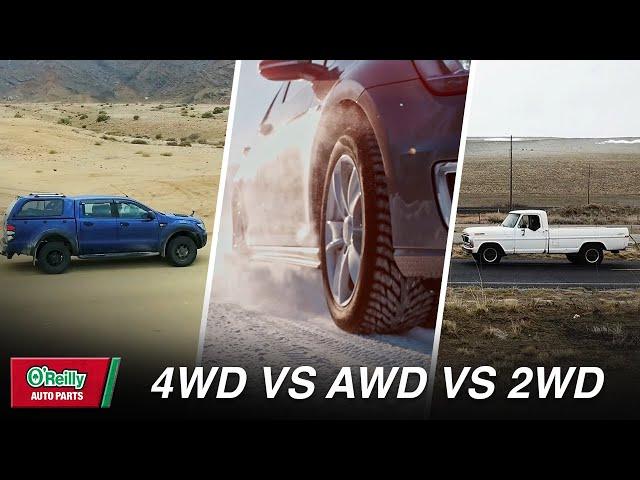
The Difference Between 4WD, AWD, and 2WD (Drivetrain Comparison)
All-wheel drive, 2-wheel drive, and 4-wheel drive are common automotive terms, but which one is better and how do they function? Knowing the positives and negatives of 2WD, 4WD, and AWD can help you make more informed decisions about the purchase of a vehicle that fits your specific needs in the future, and can equip you with knowledge you may not yet have to make an informed decision or better understand your own vehicle. This educational video explains the differences, benefits, and general functional characteristics of two-wheel drive, four-wheel drive, and all-wheel drive vehicles to help you improve your automotive knowledge.
https://www.oreillyauto.com/diy-difference-between-2wd-awd-4wd
0:00 Welcome Back
0:51 Two-Wheel Drive
1:42 Four-Wheel Drive
2:42 All-Wheel Drive
3:35 2WD vs AWD
4:08 Cons of AWD
4:58 AWD vs 4WD
5:42 Recap
Facebook: https://www.facebook.com/oreillyautoparts/
Instagram: https://www.instagram.com/oreillyautoparts/
Twitter: https://twitter.com/oreillyauto
Find your local O’Reilly Auto Parts: https://www.oreillyauto.com/locations
Check out Saab Kyles Favorite Garage Supplies: https://urlzs.com/jg78
Shop all your automotive needs: https://www.oreillyauto.com/
Subscribe and ring the notification bell! http://bit.ly/2bTyluF
Whether you are researching a new car or learning about your own, knowing the differences and similarities between cars with AWD, 2WD, and 4WD can help you understand more about vehicle drivetrains. This informational video will explain the nuances of all types of drivetrains, and will even delve into the strengths and weaknesses of two-wheel drive vs all-wheel drive vs four-wheel drive vehicles. For the right replacement parts or tools to repair your 2WD, 4WD, or AWD car, stop by your local O’Reilly Auto Parts store or shop online to simplify your next repair.
On our channel we cover several different topics:
Automotive Product Overviews
Do It Yourself Automotive Repair
DIY Auto Maintenance
Simple Automotive Diagnostics
Automotive and Vehicle Education Videos
O’Reilly Auto Parts is an auto parts retailer that provides automotive aftermarket parts, tools, supplies, equipment, and accessories in the United States serving both the professional service providers and do-it-yourself customers. From our roots as a single store in 1957 to our current size of 5,219 locations (and growing), we've come a long way. We pride ourselves on offering well researched, and reliable automotive information on our channel.
#OReillyPowered #CarRepair
#TeamOReilly #CarMaintenance
Transcript:
I was just looking at a study that said when people are going to purchase a new vehicle, over sixty percent of them will choose a four-wheel or all-wheel drive option, if it’s available. And in colder states with snowy winters, that number is up over ninety percent.
So the popularity of the four-wheel and all-wheel drive is obvious, but—why? Let’s start by taking a basic look at all the options:
I’ll start with two-wheel drive. If you don’t know anything about it, you should know two-wheel drives are powered by either the rear wheels or the front wheels of the vehicle. You’ve probably heard the terms “rear-wheel drive” and “front-wheel drive”, and those are the two types of two-wheel drive.
A lot of rear-wheel drives are gonna be muscle cars or pickup trucks. They don’t get around quite as well in winter road conditions. They tend to fishtail, which is why it helps to put weight in the back of one if conditions are snowy or icy. These vehicles perform much better under normal driving conditions.
On the other hand, front-wheel drives get around better in winter weather AND get better gas mileage, because the engine is usually smaller and directly over the wheels that power the vehicle. Front-wheel drive is what you’ll find in a lot of family vehicles, where performance isn’t as important as fuel economy and better handling when road conditions are less than ideal.
The next category is four-wheel drives. A four-wheel drive vehicle powers all four wheels, but it’ll typically be two-wheel drive UNTIL the four-wheel drive is manually engaged by a switch, a lever or shifter. In fact, driving in normal conditions with four-wheel drive engaged can actually cause problems. A lot of four-wheel drives have two settings: a low gear for things like off-roading or pulling boats out of water, and a high gear for driving on snowpack or other slick road conditions.
Now, most people, when they think of four-wheel drives, think of huge trucks, SUVs or off-road vehicles with big, knobby tires and high ground clearance. And that’s because four-wheel drive IS designed for the most extreme conditions and off-road driving.
Four-wheel drive can also come in handy if you ARE trying to pull a boat or trailer up a slippery ramp or gravelly incline where a two-wheel drive may not give you the traction you need.
https://www.oreillyauto.com/diy-difference-between-2wd-awd-4wd
0:00 Welcome Back
0:51 Two-Wheel Drive
1:42 Four-Wheel Drive
2:42 All-Wheel Drive
3:35 2WD vs AWD
4:08 Cons of AWD
4:58 AWD vs 4WD
5:42 Recap
Facebook: https://www.facebook.com/oreillyautoparts/
Instagram: https://www.instagram.com/oreillyautoparts/
Twitter: https://twitter.com/oreillyauto
Find your local O’Reilly Auto Parts: https://www.oreillyauto.com/locations
Check out Saab Kyles Favorite Garage Supplies: https://urlzs.com/jg78
Shop all your automotive needs: https://www.oreillyauto.com/
Subscribe and ring the notification bell! http://bit.ly/2bTyluF
Whether you are researching a new car or learning about your own, knowing the differences and similarities between cars with AWD, 2WD, and 4WD can help you understand more about vehicle drivetrains. This informational video will explain the nuances of all types of drivetrains, and will even delve into the strengths and weaknesses of two-wheel drive vs all-wheel drive vs four-wheel drive vehicles. For the right replacement parts or tools to repair your 2WD, 4WD, or AWD car, stop by your local O’Reilly Auto Parts store or shop online to simplify your next repair.
On our channel we cover several different topics:
Automotive Product Overviews
Do It Yourself Automotive Repair
DIY Auto Maintenance
Simple Automotive Diagnostics
Automotive and Vehicle Education Videos
O’Reilly Auto Parts is an auto parts retailer that provides automotive aftermarket parts, tools, supplies, equipment, and accessories in the United States serving both the professional service providers and do-it-yourself customers. From our roots as a single store in 1957 to our current size of 5,219 locations (and growing), we've come a long way. We pride ourselves on offering well researched, and reliable automotive information on our channel.
#OReillyPowered #CarRepair
#TeamOReilly #CarMaintenance
Transcript:
I was just looking at a study that said when people are going to purchase a new vehicle, over sixty percent of them will choose a four-wheel or all-wheel drive option, if it’s available. And in colder states with snowy winters, that number is up over ninety percent.
So the popularity of the four-wheel and all-wheel drive is obvious, but—why? Let’s start by taking a basic look at all the options:
I’ll start with two-wheel drive. If you don’t know anything about it, you should know two-wheel drives are powered by either the rear wheels or the front wheels of the vehicle. You’ve probably heard the terms “rear-wheel drive” and “front-wheel drive”, and those are the two types of two-wheel drive.
A lot of rear-wheel drives are gonna be muscle cars or pickup trucks. They don’t get around quite as well in winter road conditions. They tend to fishtail, which is why it helps to put weight in the back of one if conditions are snowy or icy. These vehicles perform much better under normal driving conditions.
On the other hand, front-wheel drives get around better in winter weather AND get better gas mileage, because the engine is usually smaller and directly over the wheels that power the vehicle. Front-wheel drive is what you’ll find in a lot of family vehicles, where performance isn’t as important as fuel economy and better handling when road conditions are less than ideal.
The next category is four-wheel drives. A four-wheel drive vehicle powers all four wheels, but it’ll typically be two-wheel drive UNTIL the four-wheel drive is manually engaged by a switch, a lever or shifter. In fact, driving in normal conditions with four-wheel drive engaged can actually cause problems. A lot of four-wheel drives have two settings: a low gear for things like off-roading or pulling boats out of water, and a high gear for driving on snowpack or other slick road conditions.
Now, most people, when they think of four-wheel drives, think of huge trucks, SUVs or off-road vehicles with big, knobby tires and high ground clearance. And that’s because four-wheel drive IS designed for the most extreme conditions and off-road driving.
Four-wheel drive can also come in handy if you ARE trying to pull a boat or trailer up a slippery ramp or gravelly incline where a two-wheel drive may not give you the traction you need.
Тэги:
#O'Reilly #Oreilly #O'Reily #four_wheel_drive #two_wheel_drive #all_wheel_drive #front_wheel_drive #rear_wheel_drive #off_roading #car_buying_guide #fwd #front_wheel_drive_cars #2wd #what_is_awd #what_is_all_wheel_drive #awd #awd_vs_4wd #the_difference_between_awd_vs_4wd #4wd #what_is_four_wheel_drive #4x4 #2wd_vs_awd #drivetrain_comparison #4x2_vs_4x4_difference #4x2 #4_wheel_drive_vs_2_wheel_drive #2_wheel_drive_vs_4_wheel_drive #4_wheel_drive #2_wheel_drive_vs_4_wheel_drive_truckКомментарии:
The Difference Between 4WD, AWD, and 2WD (Drivetrain Comparison)
O'Reilly Auto Parts
Тарас Степаненко | Невероятный гол Украины | Албания-Украина |
Футбол это жизнь!
On Air With Sanjay #239 - Aman Pratap Adhikary and Sanjeev Silpakar
Sanjay Silwal Gupta
From story to comic: Master the art of AI comic creation
Dashtoon Studio
Achari Karela- Mom Style
Moms Kitchen Ottawa
मूर्ख डॉक्टर | MURKH DOCTOR | HINDI KAHANIYA | COMEDY FUNNY STORIES
Dream Toon Comedy
Бурение и обсаживание скважины на воду
РосСпецСтрой
The Last Of Us PS5 vs PS3
GameSpot
ช่างเก่งชัยนาทมาเยือนถึงโท1....
รถดั้มสวยๆ จารัตน์ truck thailand






![• || Murder in my mind || [Cannon's and fandom's shipps] 《 all countries 》(Meme) • || Murder in my mind || [Cannon's and fandom's shipps] 《 all countries 》(Meme)](https://rtube.cc/img/upload/RTNkUEdJSV84aEM.jpg)



















